Types of flowering cacti and flowering features
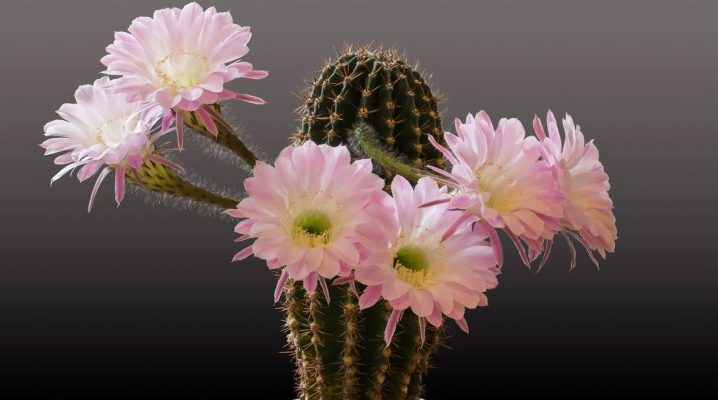
The first association that arises with the word "cactus" is their prickly needles and a green trunk. However, many species of these succulents have great flowering. Consider what varieties of flowering cacti exist, and also talk in more detail about the flowering of these plants.
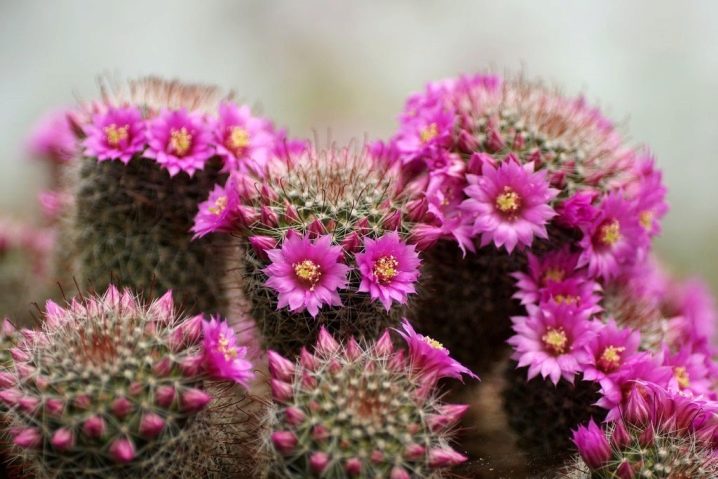
Types and varieties
In fact, every single cacti bloom, because this stage is quite natural for a plant. The fact is that not all specimens can reach the desired state for flowering due to unsuitable environmental conditions. Succulents (the so-called plants that can accumulate water in tissues, which include cacti) tend to adapt to a certain temperature and humidity. The types of flowering cacti that can throw out buds in an ordinary apartment are surprisingly diverse... Each specimen of such a plant deserves special attention. Let's list the main types of indoor flowering cacti.

Mammillaria
This compact cactus produces flowers in red, beige and even pink shades. The flowering process takes place in the summer and lasts almost the entire warm period. The buds cover the stem in a circle, and then the petals open. The flowering of mammillaria looks like a crown. Each bud lives for about a day, but a new one immediately opens up next to it. The size of the flower is small, reaching only 1 centimeter. Summer heat with ultra-high temperatures can postpone flowering until early fall. For the mammillaria to release its buds, it needs 16 hours of light a day.
If these conditions are not met even in summer, then it is better to install a source of artificial lighting nearby.


Astrophytum
The main condition for the flowering of this cactus is a small pot. This plant produces buds from Easter to late autumn. In winter, these cacti are in hibernation, and when it gets a little warmer, they release large beautiful flowers up to 8 centimeters in diameter with yellow flowers and a red center. They live up to three days, then new buds appear. This cactus does not require serious care.


Cereus
This plant does not bloom very often at home. For this to happen, certain conditions must be met. First of all, the winter dormancy of a cactus should not be disturbed. And in the spring, more frequent watering and airing is needed. If the flowers do appear, they exude a very pleasant vanilla aroma and wither after 3 days. They are yellow in color with a golden mean. The flowering period is about 4 months, from about May to early September.

Prickly pear
This cactus with flat scaly shoots is capricious, but you can provoke its flowering with the help of high temperatures and humidity. The plant blooms from April to early September. The number of buds on the shoot is significant, but they wither in the same way as in most cacti, after 1-3 days. Their color depends on the variety of the given cactus and varies from light yellow to lilac.
During the formation of buds, in no case should the pot be moved.

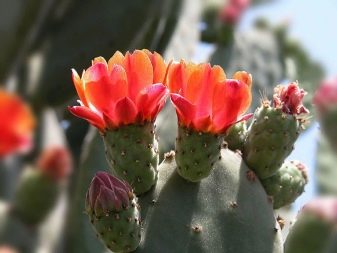
Hatiora
An interesting ampelous cactus, which is distinguished precisely by its winter flowering. This process is not as long as that of other cacti and only lasts a couple of weeks. Buds appear long before flowering. Flowers are formed at the tips of the stems and reach 5 centimeters in diameter. In order for this plant to bloom, it requires regular feeding with minerals such as calcium and phosphorus. As well as sufficient soil moisture and additional lighting.


Gymnocalycium
An important factor in the beginning of flowering for a given cactus is its age. He should not be less than two years old, and some varieties prefer to present the owner of the bud only at the age of 3. It blooms once a year from May to early autumn. Flowering often ends in summer due to insufficient light. In April, buds begin to tie on the side opposite to the sun. The buds bloom and do not wither for a week or more. Flowers of various colors: red, yellow, white.
Gymnocalycium does not require special complex care.


Rhipsalidopsis
This cactus with long, flat shoots blooms in early summer. The buds are very large, they sometimes cover the plants so that the stems are not visible. Bred varieties with red, orange and white flowers.

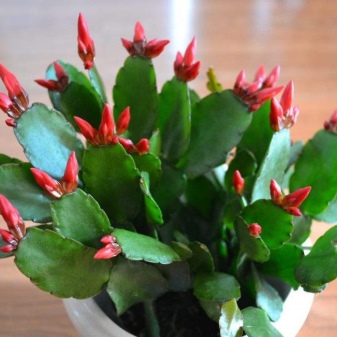
Epiphyllum
At first glance, a nondescript cactus blooms once a year for a rather short time - from late May to early June. The flowers are simply huge - they reach 12 cm in diameter, exude a sweetish aroma and differ in a variety of colors: red, orange, yellow. The cactus is undemanding to care for.


Peyote or living stone
A slow-growing cactus that can enter the flowering phase only after three years of life. It begins to bloom from late spring to autumn, flowering once. Pinkish buds, small, appear only on the "crown" of the cactus.
During flowering, this cactus loves high humidity.


Echinopsis
A very common type of cactus that blooms once in the summer. It produces a long stem, at the end of which a large white, orange, purple or pinkish flower blooms. It does not require any special growing conditions.


These are the most common types of blooming house cacti and do not require any special care. Many of them are loved and familiar to many since childhood, as they were common both in apartments and in various institutions: kindergartens, schools, libraries.
When and how often they bloom
Any succulent grower wants to enjoy their flowering at least sometimes, and he can be understood. Often, amateurs do not observe this phenomenon even once during the entire annual plant cycle. The lack of bud appearance depends on many factors.
- Type and variety of the plant. Some specimens will never bloom in an apartment in their life, as they need a tropical climate.
- The age of the cactus. Young plants almost never bloom. Usually cacti bloom from 2-3 years of age.
- Environment... Many cacti require a certain amount of light, moisture and oxygen. Not all breeders comply with this, so they never wait for flowering.


The time when a cactus blooms depends on its type and variety. At the beginning of winter, the plant usually prepares for flowering, since there are almost no varieties that bloom in winter. In winter, cacti are dormant, succulents are gaining strength before the period of flowering and reproduction. The plant wakes up in spring when daylight hours increase. Most plants bloom once a year, when buds appear on the trunks literally overnight.
This is the main sign that you will soon see a fragrant surprise on your pet. The cactus begins to prepare for reproduction, and it blooms.

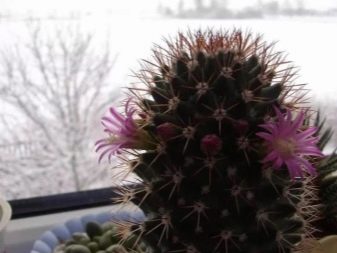
Many cactus growers are also worried about the maximum number of days a cactus can bloom. You can find out about this by studying a certain variety.
Each type of cactus pleases the eye with its flowers, but one plant blooms for a couple of days, and the other for six months.
How to make it bloom?
Getting a cactus to bloom at home is not an easy task. The existing stereotype that succulents are unpretentious plants must be dispelled.If you provoke a cactus, you can make it bloom. Any amateur gardener can do this.
- Choose the right place. The vast majority of cacti need a lot of light. Their natural habitat is the desert, where they roast all day long under the scorching sun. Rhipsalidopsis and epiphyllum belong to forest succulents, being an exception. Partial shade or windows facing the east side of the house are more suitable for them.
- Don't turn the pot. This action can only be carried out in the fall in order to avoid the curvature of the trunk. At other times, it is better not to change the position of the cactus, as this plant gets used to certain insolation. A good solution would be to mark the pots, which will help you always know exactly how the cactus stood.
- Get optimal sleep. In winter, cacti take a rest. At rest, they minimize the processes of photosynthesis. At this time of the year, you cannot install additional sources of lighting nearby, but it is better to place the plants altogether in a dark room, not forgetting which side they were facing towards the light.
- Provide optimum soil moisture. In the summertime, do not water cacti less than once a week. In winter, during a dormant state, frequent watering can lead to root rot. Therefore, in the winter season, you need to water the soil once a month, only slightly moistening it. With the beginning of spring, the procedure for spraying the cactus trunk with hot (about 45-50 ° C) water will be useful.
- Observe the winter temperature regime. Many gardeners think that since a cactus is an exotic plant, it needs year-round heat. This opinion is erroneous, because a period of low temperatures is required for the buds to set. And high temperatures only contribute to the active growth of the trunk. The best solution is to put a cactus on an insulated balcony in winter.
- Top up before flowering. If the plant feels great, then feeding is an optional condition. When other factors affecting the lack of flowering are excluded, then the fertilizer experiment may well be tried. Cacti do not perceive organic matter well, therefore it is recommended to feed them exclusively with minerals. Special fertilizers are common in stores, which should provoke budding. However, many experts consider them to be unsafe.
- If nothing else has worked, transplant the cactus. The last measure of influence on the plant is transplantation. Don't buy a huge pot. Each next dwelling should be one finger larger in diameter than the previous one.


All conditions for provoking cactus flowering are quite feasible. If you systematically move towards your goal, then your dream of seeing a beautiful flower on your pet will definitely come true. When the whole set of methods did not help, you can act on the contrary. Create stressful conditions for the cactus: do not water it a little longer than usual, move it to a new place of residence.
Perhaps the mother plant will begin to prepare for reproduction, as it will perceive such signals as a threat to life.

Care rules
It is necessary to take care of a blooming cactus correctly. The further vitality of the plant and the abundance of flowering depend on this. During this beautiful period, optimal conditions must be maintained for the succulent.
- Lack of transfers. Even if it seems to you that there is not enough space for the cactus in the pot, the transplant should be left for later. By stirring a flowering plant, you can completely stop flowering, not only at the moment, but also for subsequent years.
- No fertilizers. During flowering, you need to eliminate any stress for the cactus - both negative and positive. Fertilizers can provoke increased plant growth, which will have a negative effect on the further ovary of buds.
- The location of the cactus must be constant. The plant prepares the buds for flowering for a long time, choosing the optimal place on the trunk for their formation.If, during flowering and budding, the succulent is deployed and moved, this can provoke a stop of these periods.
- The direction of the light should not change. Even a new curtain can ruin the bloom of a cactus. This period is not a time for experimentation. The sun's rays should fall on the plant in one position.
- Optimal watering. During flowering, cacti should receive enough moisture. The water should not be too cold. It is better to water the plant during this period every 3-5 days.
- Airing... During the flowering period, one should not forget about the flow of fresh air. Without oxygen and movement of air masses, the plant may not receive the necessary stress for high-quality budding.

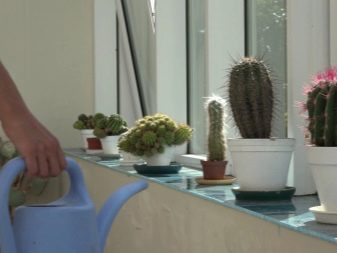
For information on how to make a cactus bloom, see the next video.













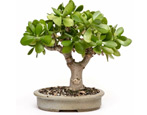




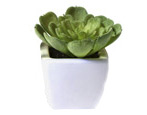








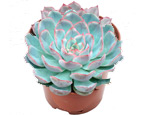



























The comment was sent successfully.